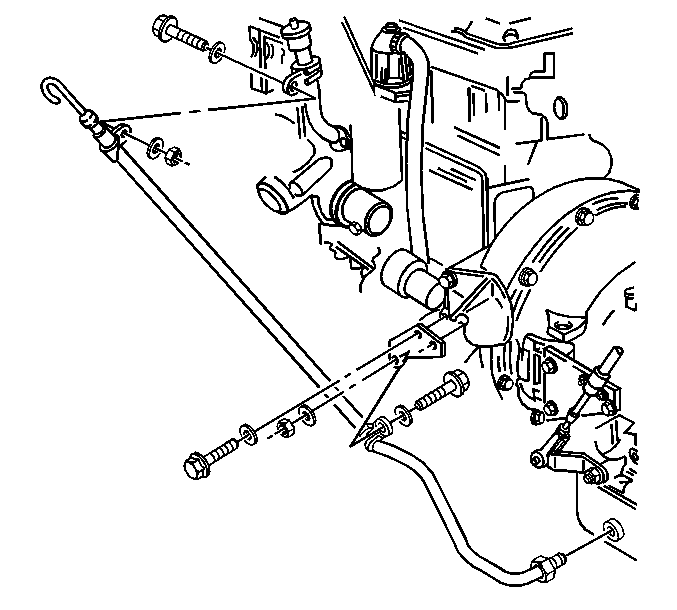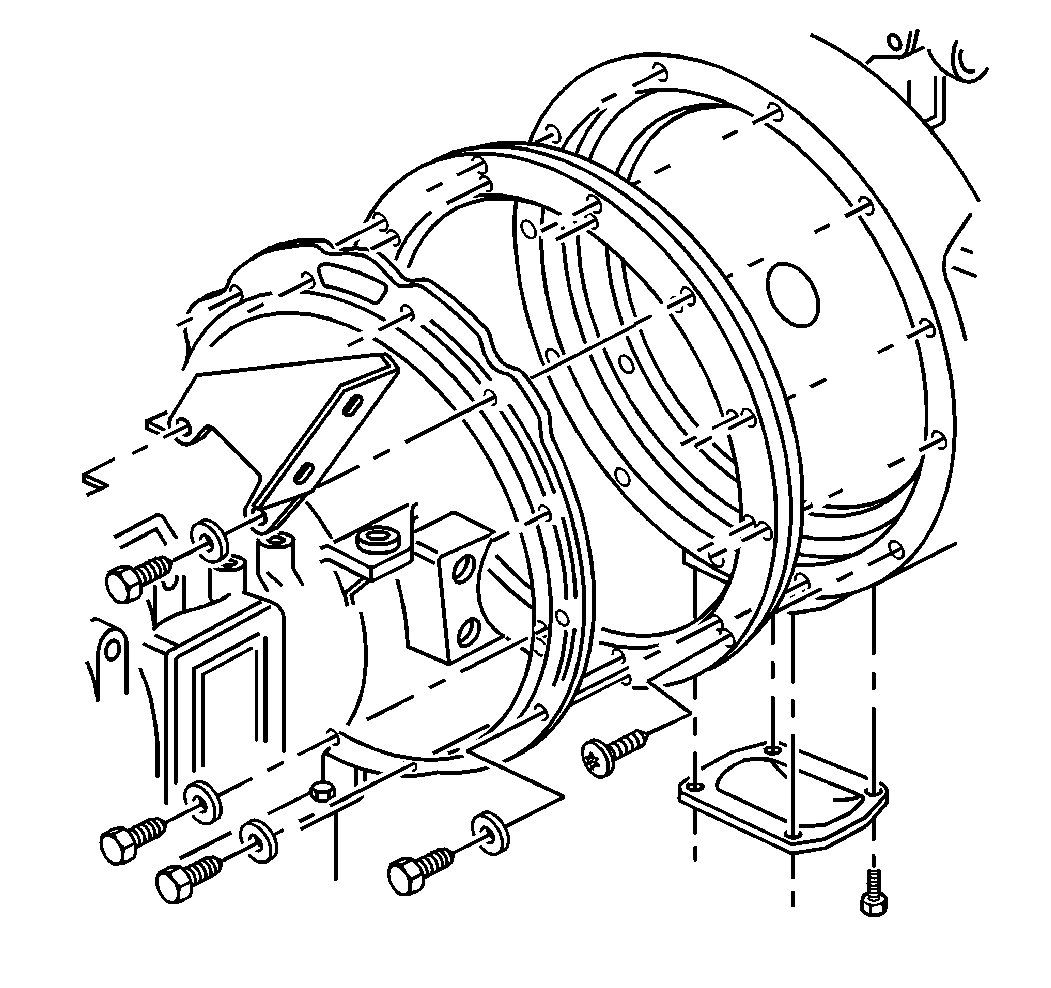Removal Procedure
- Block the wheels.
- Disconnect the negative battery cable. Refer to Battery Negative Cable Disconnection and Connection in Engine Electrical.
- Drain the transmission oil. Refer to Automatic Transmission Fluid and Filter Replacement .
- Remove the transmission oil level indicator and the oil level indicator tube. Refer to Transmission Fluid Filler Tube and Seal Replacement .
- Remove the oil cooler lines from the transmission.
- Remove the shift cable from the transmission.
- Remove the wiring harness and disconnect the transmission electrical connectors.
- Remove the propeller shaft. Refer to One-Piece Propeller Shaft Replacement , Two-Piece Propeller Shaft Replacement or Three-Piece Propeller Shaft Replacement in Propeller Shaft.
- Remove the parking brake cable from the brake drum.
- Determine what type of front engine mount is on the vehicle and take the following steps when removing the rear engine mounting bolts:
- Remove the transmission rear support beam, if equipped.
- Remove the rear engine mounting bolts, if the mounts are not attached to the engine flywheel housing.
- Support the rear of the engine on a jack stand.
- Install the transmission jack to the transmission.
- Install a safety chain to secure the transmission to the transmission jack.
- Remove the bolts securing the transmission to the engine.
- Remove the transmission from the engine by sliding the transmission rearward.
- Lower and remove the transmission from the vehicle.

Important: The following transmission replacement procedure serves as a guide. In order to provide enough clearance for removal of the transmission, removal of other components may be necessary on some vehicles. Information on the removal of other components are not included in this transmission replacement procedure.
Caution: Unless directed otherwise, the ignition and start switch must be in the OFF or LOCK position, and all electrical loads must be OFF before servicing any electrical component. Disconnect the negative battery cable to prevent an electrical spark should a tool or equipment come in contact with an exposed electrical terminal. Failure to follow these precautions may result in personal injury and/or damage to the vehicle or its components.



NOTICE: Carefully inspect the transmission and the surrounding areas to be sure no lines, hoses or wires will interfere with the transmission removal. In order to avoid damage to the transmission or the torque converter, support the transmission with a dolly jack. Do not let the torque converter fall.
| • | If the mount is a single cushion, center mount, support the engine with an overhead hoist during the transmission replacement in order to prevent tipping. |
| • | If the rear engine mounting bolts are not attached to the engine flywheel housing, support the rear of the engine on a jack stand. |
| 10.1. | Remove the flywheel housing access cover. |
| 10.2. | Turn the flex plate using a pry bar in order to align the torque convertor bolts with the access hole. |
| 10.3. | Remove the torque convertor bolts. |

Important: Support the transmission with a transmission jack that can support a load of at least 349 kg (750 lb).

Installation Procedure
- Raise the transmission to the engine.
- Install the transmission to the engine while aligning the torque converter with the pilot hole in the engine flex plate.
- Install the transmission to engine bolts.
- Turn the engine flex plate using a pry bar in order to install the torque converter to flywheel bolts.
- Install the torque converter to flywheel bolts.
- Install the flywheel housing access cover.
- Install the transmission rear support beam, if equipped.
- Install the transmission mounting nuts to the rear support beam.
- Install the rear engine mount bolts, if the mounts are attached to the transmission case. Refer to Engine Mount Replacement .
- Install the cushion, the bolts, and the washers to the frame bracket, if equipped.
- Install the cushion to support nuts and the shims, as needed.
- Remove the safety chain and the transmission jack from the transmission.
- Install the parking brake cable to the park brake drum.
- Install the oil cooler lines to the transmission.
- Install the oil level indicator tube. Refer to Transmission Fluid Filler Tube and Seal Replacement .
- Connect the transmission electrical connectors and install the wiring harness to the transmission.
- Install the propeller shaft to the transmission. Refer to One-Piece Propeller Shaft Replacement , Two-Piece Propeller Shaft Replacement or Three-Piece Propeller Shaft Replacement in Propeller Shaft.
- Install the shift cable to the transmission.
- Fill the transmission with DEXRON III transmission fluid. Automatic Transmission Fluid and Filter Replacement .
- Connect the negative battery cable. Refer to Battery Negative Cable Disconnection and Connection in Engine Electrical.
- Remove the wheel blocks.

NOTICE: Carefully inspect the transmission and the surrounding area to be sure no lines, hoses or wires will interfere with the transmission installation. When raising and moving the transmission, do not let the torque converter slip off the shaft. The transmission or torque converter can be damaged.

Notice: Use the correct fastener in the correct location. Replacement fasteners must be the correct part number for that application. Fasteners requiring replacement or fasteners requiring the use of thread locking compound or sealant are identified in the service procedure. Do not use paints, lubricants, or corrosion inhibitors on fasteners or fastener joint surfaces unless specified. These coatings affect fastener torque and joint clamping force and may damage the fastener. Use the correct tightening sequence and specifications when installing fasteners in order to avoid damage to parts and systems.
Tighten
Tighten the transmission to engine bolts to 55 N·m (41 lb ft).

Tighten
Tighten the torque converter to flywheel bolts to 67 N·m
(49 lb ft).
Tighten
Tighten the nuts to 105 N·m (77 lb ft).
Tighten
Tighten the cushion to the bracket nuts to 45 N·m (33 lb ft).
Tighten
Tighten the cushion to support nuts to 31 N·m (23 lb ft).




